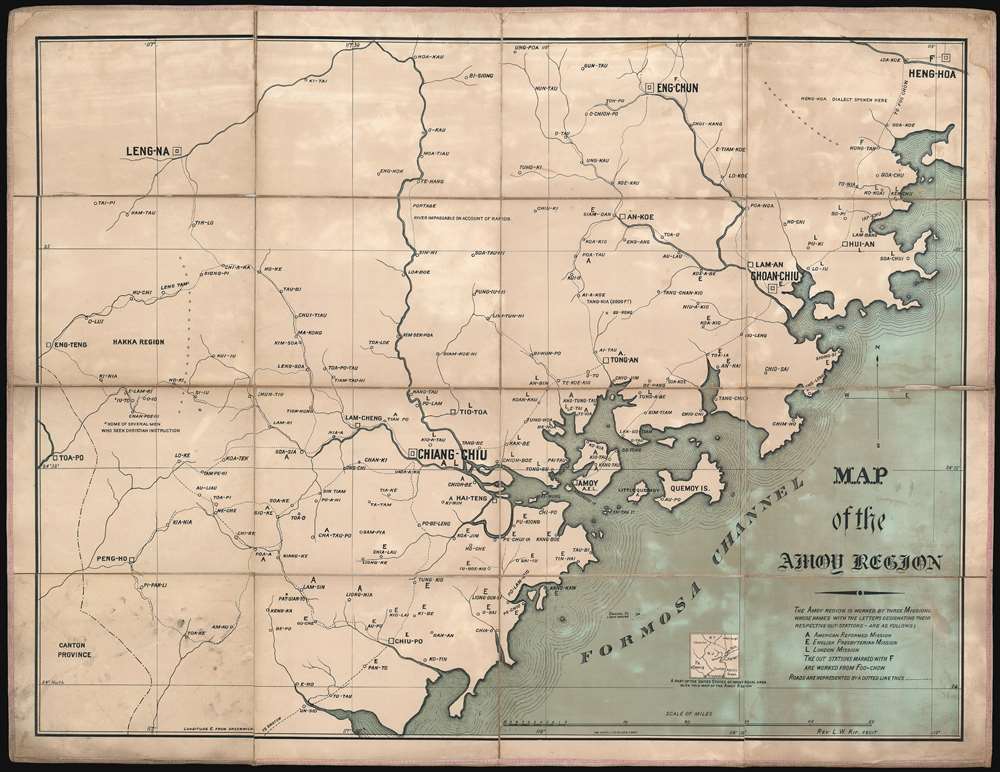This item has been sold, but you can get on the Waitlist to be notified if another example becomes available, or purchase a digital scan.
1880 L. W. Kip First Missionary Map of Xiamen (Amoy), Fujian, China
AmoyXiamenMissionary-kip-1880
Title
1880 (undated) 26 x 33.5 in (66.04 x 85.09 cm) 1 : 300000
Description
Kip's Missionary Work among the Hakka
Kip was active in and around Amoy from 1861 to 1899. He particularly enjoyed field work and spent much of his time on foot aboard 'gospel boats' traveling between distant villages. Kip's greatest energy focused on proselytization of the tribal Hakka people, known for their iconic communal tolous, essentially fully contained multi story villages. The 'Hakka Region' and numerous villages are noted.Chromolithography
Chromolithography is a color lithographic technique developed in the mid-19th century. The process involved using multiple lithographic stones, one for each color, to yield a rich composite effect. Oftentimes, the process would start with a black basecoat upon which subsequent colors were layered. Some chromolithographs used 30 or more separate lithographic stones to achieve the desired effect. Chromolithograph color could also be effectively blended for even more dramatic effects. The process became extremely popular in the late 19th and early 20th centuries, when it emerged as the dominate method of color printing.Publication History and Census
The present map, issued in chromolithograph by the Hatch Lithographic Company of New York is the 1880 first edition of Kip's map. A significantly revised and updated version of this map, also crediting Kip was published in London by Unwin Brothers in 1902 and 1904. A further revised and updated Chinese edition was published with pinyin text in 1907 and 1909, potentially for postal use.While the more advanced maps rare, appearing in a few institutional collections, we have identified no other examples of this American 1880 edition. The map in its present edition, is referenced in some missionary records, but exists in no known institutional collections. The presently offered map is potentially the only surviving example.
CartographerS
Leonard W. Kip (November 10, 1837 - February 27, 1901) was an American missionary active in China during the second half of the 19th century. Kip was born in New York City to a wealthy family, but nonetheless, joined the China Board in his religious devotion. Kip first traveled to China in 1861 with the Chinese Mission of the American Reformed Church and established himself at the Amoy (Xiamen) mission. Kip was extremely zealous in parenthesizing the Christian Gospel and traveled extensively through the region. With is educational background, and extensive travels, Kip became the unofficial geographer of the mission, compiling the first accurate western style map of the Xiamen region. He remained with the mission until 1899, at which point, in ill health he returned to the United States, dying 2 years later, in 1901. There are some, apparently erroneous, reports that he may have died in Xiamen, China. More by this mapmaker...
George Whitefield Hatch (1805 - 1867) was an American lithographer, viewmaker, and portraitist, based in New York. Hatch was born in Johnstown, New York, the son of George Whitefield Hatch Sr. (1770 - 1829). He moved to New York city in the Mid 1820s to study engraving and painting under Asher Brown Durand (1796 - 1886). He then moved to Albany, where he was active as an engraver as early as 1831, when he issued works with James Smillie under the imprint of 'Hatch and Smillie'. In 1832, he returned to New York to become a partner in the banknote engraving firm of Rawdon, Wright, and Hatch. Banknote work led him to become a founding partner in the American Banknote Company, of which he was president between 1863 and 1866. In 1853, he partnered with Charles Severyn (1820 - 18??) to found 'Hatch and Severyn,' a new firm specializing in chromolithography. When Hatch's son George Whitefield Hatch Jr. (1830 - 1856) and his younger brother Warner Daniels Hatch (1831 - 1884) joined the firm shortly afterwards, the imprint was revised to 'Hatch and Co.' George Whitefield Hatch Jr. died in 1856, at just 26, Warner Daniels Hatch became a full partner. When George Whitefield Hatch Sr. died in 1867, Warner Daniels Hatch took on full management. The company reorganized in 1872 as the 'Hatch Lithographic Company'. On July 18, 1884, The New York Sun News reported that Warner D. Hatch drowned under mysterious circumstances, possibly suicide. While active the Hatch firm specialized in chromolithography, certificates, trade cards, and advertising. Management fell to Warner Hatch Nostrand, who ran the company until 1889, when it was dissolved under insolvency. Learn More...

